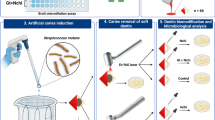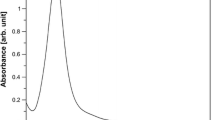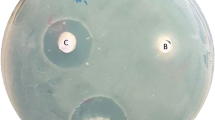Abstract
The purpose of the present study was to examine the effects of a newly developed water-soluble reduced chitosan on Streptococcus mutans, plaque regrowth, and biofilm vitality. A 1.0%, water-soluble reduced chitosan, with pH ranging from 6.0 to 6.5, molecular weights between 3,000 and 5,000 Da, and 70% degree of deacetylation, was used. To determine antibacterial and antiplaque potency of chitosan, minimal inhibitory concentrations (MICs) for S. mutans and S. sanguinis (formerly S. sanguis), short-term exposure to S. mutans, and clinical trial of plaque regrowth and biofilm vitality were conducted. Twelve dental students volunteered to participate in the 6-week, double blind, randomized clinical trial using the classical 4-day plaque regrowth design. The MIC of water-soluble reduced chitosan for S. mutans was 1.25 g/l. While the cells exposed to distilled water (DW) grew rapidly, with a maximum turbidity reached by 16 h postinoculation, S. mutans exposed to chitosan (5.0 g/l) exhibited a substantial delay in growth and reached a maximum turbidity by 32 h postinoculation. The chitosan solution reduced the plaque index and the vitality of the plaque flora significantly when compared to DW, but this was less than the reductions found with the positive control of 0.1% chlorhexidine solution. The water-soluble reduced chitosan exhibited potent antibacterial effect on S. mutans, and displayed a significant antibacterial and plaque-reducing action during the 4-day plaque regrowth.

Similar content being viewed by others
References
Addy M, Moran J, Griffiths AA, Wills-Wood NJ (1985) Extrinsic tooth discoloration by metals and chlorhexidine. I. Surface protein denaturation or dietary precipitation? Br Dent J 159:281–285
al-Delaimy KS, Ali SH (1970) Antibacterial action of vegetable extracts on the growth of pathogenic bacteria. J Sci Food Agric 21:110–112
Arweiler NB, Henning G, Reich E, Netuschil L (2002) Effect of an amine–fluoride–triclosan mouthrinse on plaque regrowth and biofilm vitality. J Clin Periodontol 29:358–363
Baker PJ, Coburn RA, Genco RJ, Evans RT (1987) Structural determinants of activity of chlorhexidine and alkyl bisbiguanides against the human oral flora. J Dent Res 66:1099–1106
Binney A, Addy M, McKeown S, Everatt L (1996) The choice of controls in toothpaste studies. The effect of a number of commercially available toothpastes compared to water on 4-day plaque regrowth. J Clin Periodontol 23:456–459
Brecx M, Netuschil L, Reichert B, Schreil G (1990) Efficacy of Listerine, Meridol and chlorhexidine mouthrinses on plaque, gingivitis and plaque bacteria vitality. J Clin Periodontol 17:292–297
Brecx M (1997) Strategies and agents in supragingival chemical plaque control. Periodontol 2000 15:100–108
Choi BK, Kim KY, Yoo YJ, Oh SJ, Choi JH, Kim CY (2001) In vitro antimicrobial activity of a chitooligosaccharide mixture against Actinobacillus actinomycetemcomitans and Streptococcus mutans. Int J Antimicrob Agents 18:553–557
Choi HJ, Lee HS, Her S, Oh DH, Yoon SS (1999) Partial characterization and cloning of leuconocin J, a bacteriocin produced by Leuconostoc sp. J2 isolated from the Korean fermented vegetable Kimchi. J Appl Microbiol 86:175–181
Decker EM, von Ohle C, Weiger R, Wiech I, Brecx M (2005) A synergistic chlorhexidine/chitosan combination for improved antiplaque strategies. J Periodontal Res 40:373–377
Drake DR, Wefel JS, Dunkerson D, Hogle K (1993) The antimicrobial activity of Prevention mouthrinse. Am J Dent 6:239–242
Flotra L, Gjermo P, Rolla G, Waerhaug J (1971) Side effects of chlorhexidine mouth washes. Scand J Dent Res 79:119–125
Fujiwara M, Hayashi Y, Ohara N (2004) Inhibitory effect of water-soluble chitosan on growth of Streptococcus mutans. New Microbiol 27:83–86
Holme KR, Perlin AS (1997) Chitosan N-sulfate. A water-soluble polyelectrolyte. Carbohydr Res 302:7–12
Ikinci G, Senel S, Akincibay H, Kas S, Ercis S, Wilson CG, Hincal AA (2002) Effect of chitosan on a periodontal pathogen Porphyromonas gingivalis. Int J Pharm 235:121–127
Järvinen H, Tenovuo J, Huovinen P (1993) In vitro susceptibility of Streptococcus mutans to chlorhexidine and six other antimicrobial agents. Antimicrob Agents Chemother 37:1158–1159
Johnson MG, Vaughn RH (1969) Death of Salmonella typhimurium and Escherichia coli in the presence of freshly reconstituted dehydrated garlic and onion. Appl Microbiol 17:903–905
Keene HJ, Shklair IL (1974) Relationship of Streptococcus mutans carrier status to the development of carious lesions in initially caries free recruits. J Dent Res 53:1295
Kim JH (1995) Inhibition of Listeria monocytogenes by bacteriocin from lactic acid bacteria isolated from kimchi. Agric Chem Biotechnol 38:302–307
Kornman KS (1985) Antimicrobial agents. National Institute of Dental Research, Bethesda, pp 150–194
Löe H and Silness J (1963) Periodontal disease in pregnancy: I. Prevalence and severity. Acta Odontol Scand 21:533–551
Miyazaki S, Nakayama A, Oda M, Takada M, Attwood D (1994) Chitosan and sodium alginate based bioadhesive tablets for intraoral drug delivery. Biol Pharm Bull 17:745–747
Moran J, Addy M, Newcombe RG, Marlow I (2000) A study to assess the plaque inhibitory activity of a new triclosan mouthrinse formulation. J Clin Periodontol 27:806–809
Netuschil L, Reich E, Brecx M (1989) Direct measurement of the bactericidal effect of chlorhexidine on human dental plaque. J Clin Periodontol 16:484–488
Netuschil L, Weiger R, Preisler R, Brecx M (1995) Plaque bacteria counts and vitality during chlorhexidine, meridol and listerine mouthrinses. Eur J Oral Sci 103:355–361
Newcombe RG (1992) Crossover trials comparing several treatments. J Clin Periodontol 19:785–787
Newcombe RG, Addy M, McKeown S (1995) Residual effect of chlorhexidine gluconate in 4-day plaque regrowth crossover trials, and its implications for study design. J Periodontal Res 30:319–324
Perneger TV (1998) What's wrong with Bonferroni adjustments. BMJ 316:1236–1238
Reichart P, Gehring F (1984) Streptococcus mutans and caries prevalence in Lisu and Karen of northern Thailand. J Dent Res 63:56–58
Rölla G, Kjærheim V, Waaler SM (1994) The role of antiseptics in primary prevention. In: Lang NP, Karring T (eds) Proceedings of the second European Workshop in Periodontology. Quintessence, London
Schiött CR, Loe H, Jensen SB, Kilian M, Davies RM, Glavind K (1970) The effect of chlorhexidine mouthrinses on the human oral flora. J Periodontal Res 5:84–89
Seo H, Shoji A, Itoh Y, Kawamura M, Sakagami Y (1994) Antibacterial fiber blended with chitosan. In: Karnicki ZS, Brzeski MM, Bykowski PJ, Wojtasz-Pajak A (eds) Chitin world. Wirtschaftverlag NV-Verlag für neue Wissenschaft GmbH, Germany, pp 623–631
Silness J, Löe H (1964) Periodontal disease in pregnancy (II). Correlation between oral hygiene and periodontal condition. Acta Odontol Scand 22:121–135
Sugimoto M, Morimoto M, Sashiwa H, Saimoto H, Shigemasa Y (1998) Preparation and characterization of water-soluble chitin and chitosan derivatives. Carbohydr Polym 36:49–59
Tarsi R, Muzzarelli RA, Guzman CA, Pruzzo C (1997) Inhibition of Streptococcus mutans adsorption to hydroxyapatite by low-molecular-weight chitosans. J Dent Res 76:665–672
Tarsi R, Corbin B, Pruzzo C, Muzzarelli RA (1998) Effect of low-molecular-weight chitosans on the adhesive properties of oral streptococci. Oral Microbiol Immunol 13:217–224
Tsai GJ, Zhang SL, Shieh PL (2004) Antimicrobial activity of a low-molecular-weight chitosan obtained from cellulase digestion of chitosan. J Food Prot 67:396–398
Turesky S, Gilmore ND, Glickman I (1970) Reduced plaque formation by the chloromethyl analogue of victamin C. J Periodontol 41:41–43
Yang TC, Chou CC, Li CF (2005) Antibacterial activity of N-alkylated disaccharide chitosan derivatives. Int J Food Microbiol 97:237–245
Acknowledgement
The statistical advice of Choongrak Kim (Pusan National University, Busan, South Korea) is gratefully acknowledged.
Author information
Authors and Affiliations
Corresponding author
Rights and permissions
About this article
Cite this article
Bae, K., Jun, E.J., Lee, S.M. et al. Effect of water-soluble reduced chitosan on Streptococcus mutans, plaque regrowth and biofilm vitality. Clin Oral Invest 10, 102–107 (2006). https://doi.org/10.1007/s00784-006-0038-3
Received:
Accepted:
Published:
Issue Date:
DOI: https://doi.org/10.1007/s00784-006-0038-3




